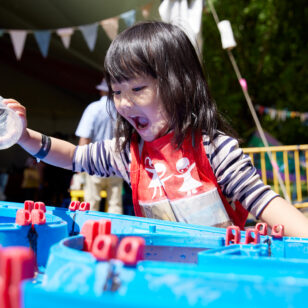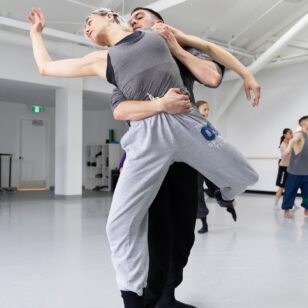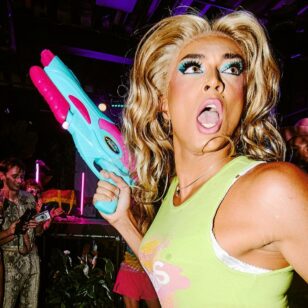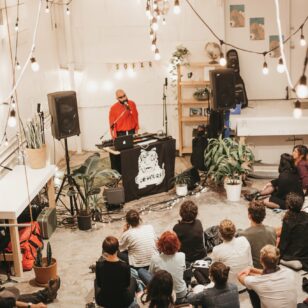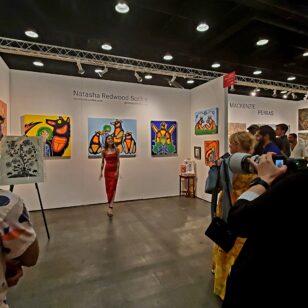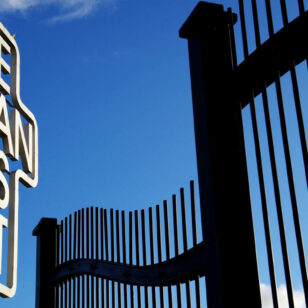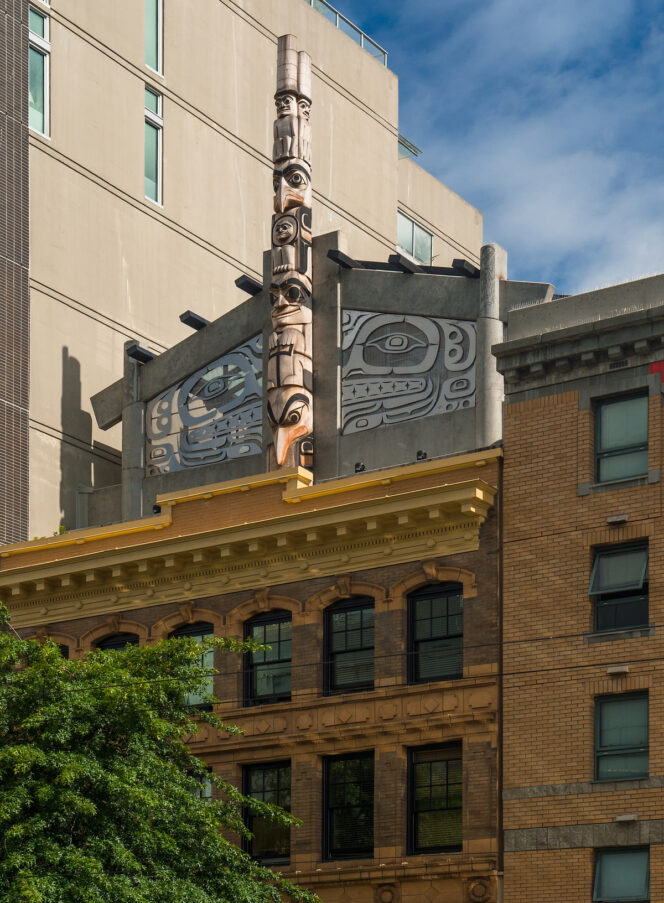
Skwachàys Lodge; Photo: Craig Minielly at Aura Photographics
Gerry Sheena, a carver and member of the Interior Salish Nation, returned to his craft through the Artists in Residence program at Skwachàys Lodge. “I strayed way off track for six years. I was deep in trouble and in darkness,” he says.
“I was trying to turn a new leaf. I was told about Skwachàys, so I thought ‘I’m going to apply. I’ve got nothing to lose, and I still have a pretty good portfolio.’” The result was a three-year residency at Skwachàys from 2016 to 2019, which connected Sheena again with his carving, his culture, and himself.
Skwachàys Lodge (pronounced ‘swatch-eyes’) is truly a unique place. It’s the first Indigenous Art Hotel in Canada, containing 18 guest suites featuring local Indigenous artwork on its top three floors, in addition to an Urban Aboriginal Fair Trade Gallery on its ground floor for showcasing and selling the work of local Indigenous artists. But Skwachàys Lodge is even more special because of the social enterprise embedded in its concept.
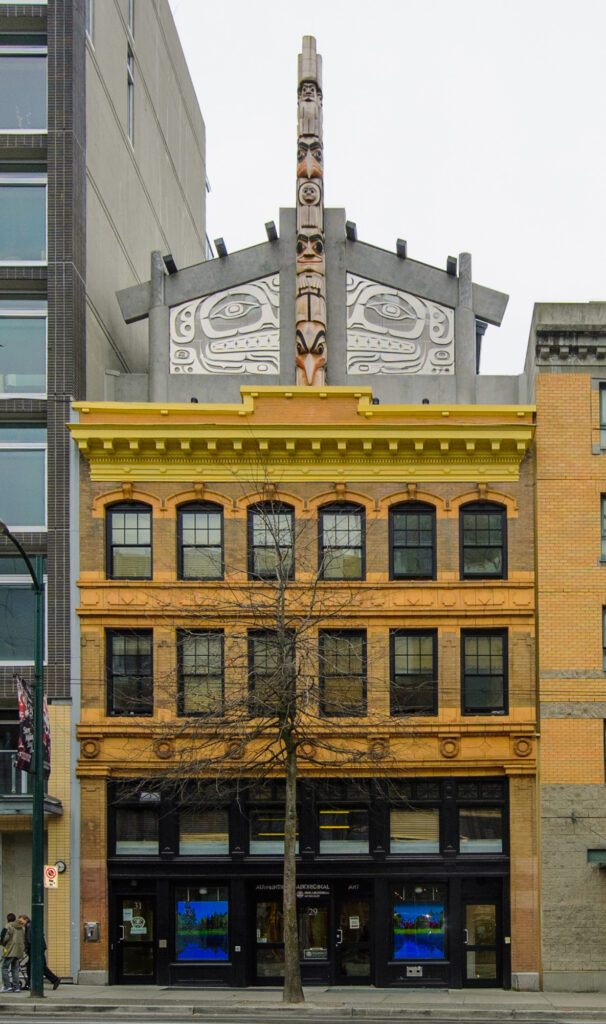
Skwachàys Lodge; Photo: Craig Minielly at Aura Photographics
“Skwachàys Lodge and Gallery is owned and operated by the Vancouver Native Housing Society. We have over 20 buildings in the city. This is the only building with two social enterprises, which is the gallery and the hotel. We subsidize 24 units for artists in residence, and we give them a studio space as well. It’s all based around supporting our Indigenous artists in the city as well as supporting our social housing for Indigenous people that live here,” says Caroline Phelps, Guest Experience and Culture Liaison Lead at Skwachàys Lodge.
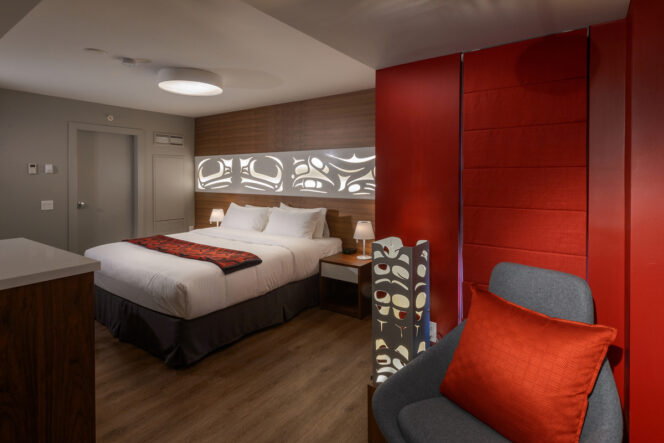
Skwachays Lodge; Photo: Craig Minielly at Aura Photographics
The Vancouver Native Housing Society (VNHS) is a non-profit organization with an exclusively Indigenous Board of Directors. It provides affordable and safe individual, family, and supportive housing in the Downtown Eastside, the West End, and Grandview-Woodlands and Commercial-Broadway neighbourhoods. Skwachàys Lodge and Gallery is a pillar for the championing and sharing of Indigenous culture and art.
The Artists in Residence Program, which has been running for six years, is open to any practising Indigenous artist (First Nations, Métis, or Inuit). Once accepted, the artists rent bachelor suites ($416 per month) for up to three years. They’re also required to contribute 8 volunteer hours per month. In addition to subsidized housing and a shared studio space, the artists receive support for their professional development. “Some of the artists who come into the program are already established. But we also help others in getting established, and we do still support them even after they’ve gone out of the program,” says Phelps.
Alumni of the multi-disciplinary program include Corinne Hunt, who co-designed the medals for the 2010 Winter Olympics and contributed her art to the guestrooms at Skwachàys Lodge; and Grace Dove, an actress who starred in Monkey Beach.
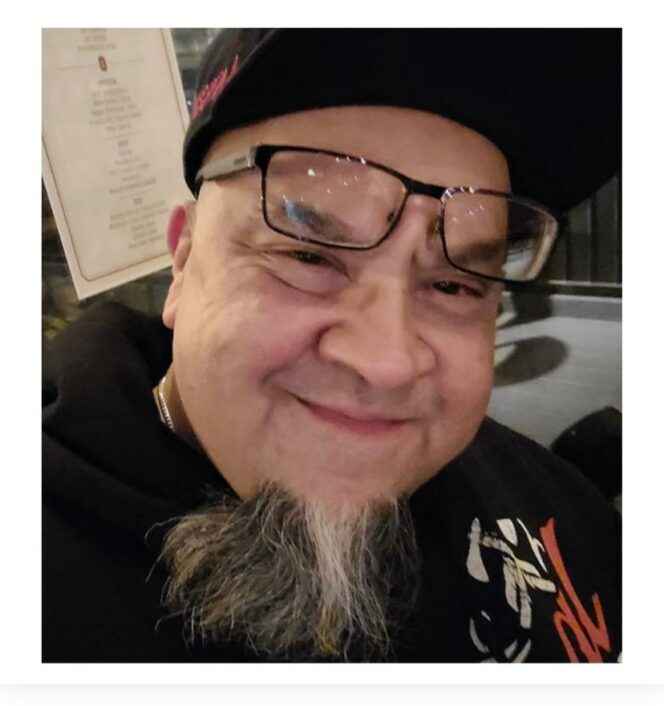
Carver Gerry Sheena
Born in Merritt, BC, fellow alumni Gerry Sheena found himself naturally gravitating to art but it wasn’t until a visit to a local artist, that he realized that he could turn his talent into a viable career. His nation, the Interior Salish, are known for their basket weaving but Sheena had a deep passion for wood carving, particularly by Coast Salish artists. “I was drawn to it. My father was a logger, so I grew up with the smell of wood ingrained in my DNA. When I first saw carvings, I thought, “Wow, I wish I could do that.’”
Sheena began carving over three decades ago, initially guided by the work of his brother Roger Swakum, who was skilled in 2D board carving. Sheena’s work is based on Coast Salish carving techniques, much of which he acquired through self-instruction by doing research and visiting museums to study earlier works. He was also welcomed into the contemporary carving community on the west coast, learning skills from those immersed in his craft. He cites prominent carvers like Beau Dick and Susan Point as artistic influences.
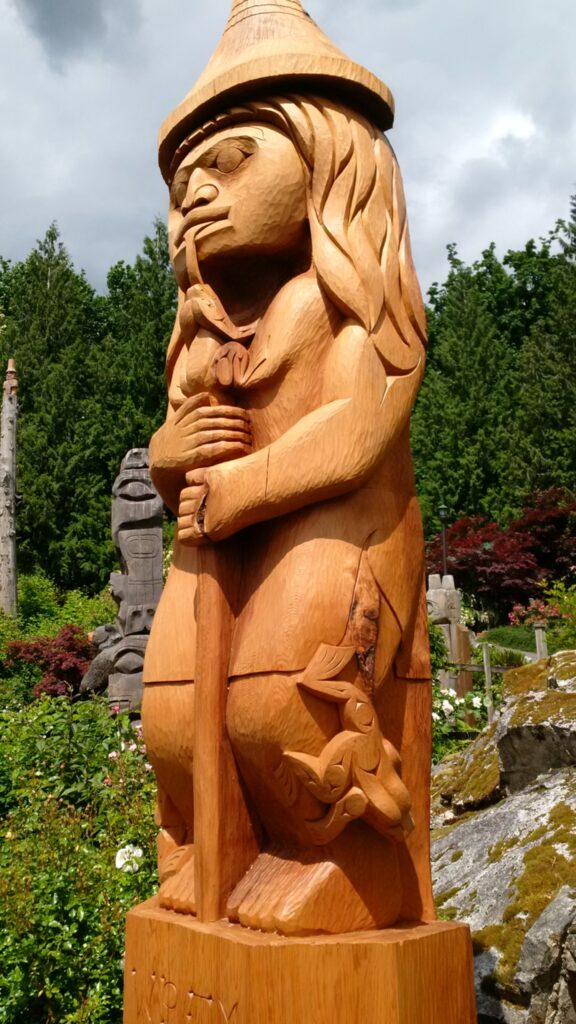
Photo sourced from Gerry Sheena
For Sheena, carving became a way of reclaiming a sense of Indigenous culture and pride. “Culturally, a lot of First Nations people grow up mainstream. A lot of us have been denied our culture and know nothing of our culture. We’re born into a generation trying to bring it back and revive it,” he says. He sees himself as continuing the vital work that others started. “There’s a bunch of us who are trying to pick up the torch and keep going with it,” he says.
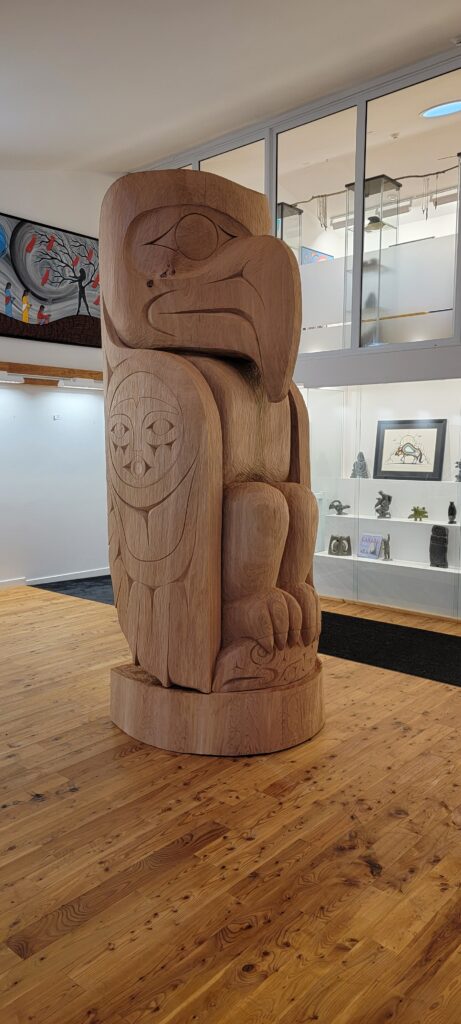
Photo sourced from Gerry Sheena
The importance of this cultural work remained with Sheena even when he entered a tumultuous period of his life. “During that time, I didn’t carve at all. Although, one thing I’ve always had is respect for carving. It’s a sacred thing,” he says. Before he applied to become an Artist in Residence at Skwachàys, Sheena felt the pull of his carving. “It was calling me back. I was dreaming about it a lot,” he says.
Sheena is deeply grateful for the three-year residency and the personal recovery and artistic growth it afforded. “Skwachàys gave me the chance. They gave me a space to work – a studio – a place to live and rest my head. Because I hadn’t worked for a long time, I was out of touch with a lot of gallery people and contacts I had made over the years,” he says. Living and creating with fellow Indigenous artists spurred more learning for Sheena, as well as fostered connections.
Over the course of the three years at Skwachàys, Sheena went back to what he had been doing since 1988: carving masks, bowls, rattles, plaques, and totem poles, mostly in red cedar. “It’s what the forefathers used. It’s a traditional wood for many reasons. It’s good because it lasts a long time, so a carved totem pole outside lasts a long time. And the wood grain is pretty straight for when you’re making boards and planks,” he says.
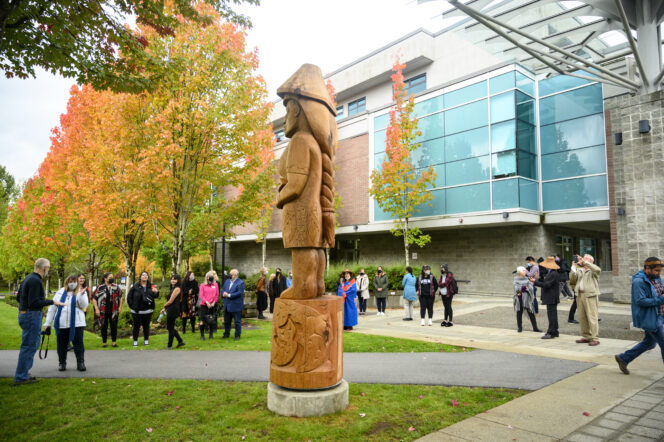
Douglas College Pole Unveiling; Photo sourced from Gerry Sheena
Sheena particularly likes carving masks and totem poles, with the latter letting him work with large pieces of wood in what he describes as a continual learning process. While he carves a range of animal figures, salmon reoccurs in his work. “I always try to incorporate salmon. I feel a close-knit connection with salmon because, basically, so many of us and so many animals rely on it. But we’re the ones overfishing it and polluting its waters. We’re the ones making it difficult for them to flourish. We still continue to take so much from them,” he says.
Currently, Sheena is working on a panel with a mother killer whale teaching her calf to hunt three salmon. He’ll leave this carving unpainted. “I’m more of a fan of natural wood. On masks, I don’t mind painting designs, like an eagle or a salmon, but I always try to leave some of the natural wood [unpainted],” he says.
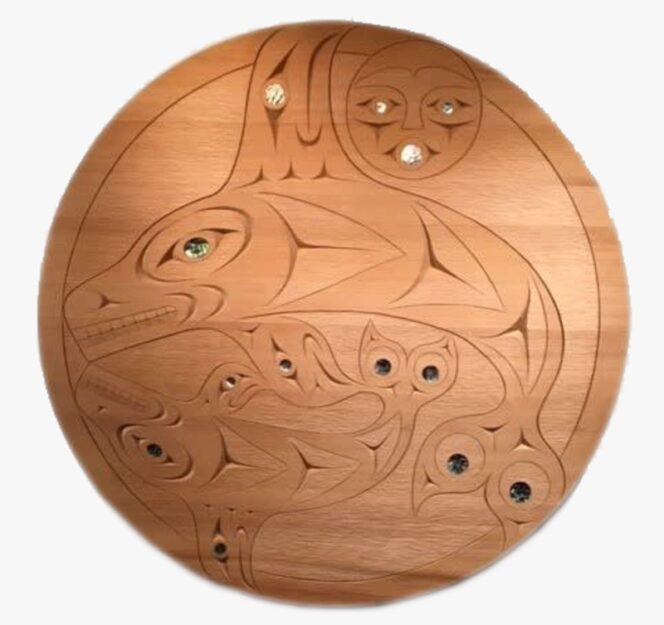
Killer Whale Panel
A carved Killer Whale Panel by Sheena can be found and purchased at the Skwachàys Urban Aboriginal Fair Trade Gallery. Also for sale is an Eagle Plaque, as well as a stunning Eagle Salmon Round Panel. A host of other Indigenous artists are also featured in the Gallery, such as Victoria Harper who makes beautiful silver jewelry and Patrick Amos who specializes in Nuu-cha-nulth paintings and prints.
Both Skwachàys Lodge and artists like Sheena deeply value the cultural transmission aspect of the artwork. Sheena mentors Indigenous youth in order to keep Coast Salish carving vibrant. “There are a few that are interested, and those are the ones that we have to reach because then it will be their turn to keep it alive and pass it on to the generations closer to them,” he says.











